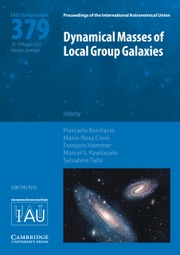No CrossRef data available.
Article contents
Galaxies Unveiled: Rest-frame UV Clumps at 0.5 < z < 1.5
Published online by Cambridge University Press: 21 March 2017
Abstract
Studies of high redshift galaxies reveal compact sub-galactic regions of star formation, known as ‘clumps’. These ‘clumpy’ galaxies are useful for the study of galactic outskirts by enabling us to examine the radial progression of clumps over large time scales. We use the first deep high resolution NUV image from the Hubble Space Telescope covering intermediate redshifts to explore the implications this radial progression may have on galaxy evolution. From the analysis of 209 clumpy galaxies, we find that higher redshift clumps dominate the outer regions of galactic outskirts. This indicates that clumps may be migrating from the outskirts inward toward their galactic centers.
- Type
- Contributed Papers
- Information
- Proceedings of the International Astronomical Union , Volume 11 , Symposium S321: Formation and Evolution of Galaxy Outskirts , March 2016 , pp. 364 - 365
- Copyright
- Copyright © International Astronomical Union 2017




